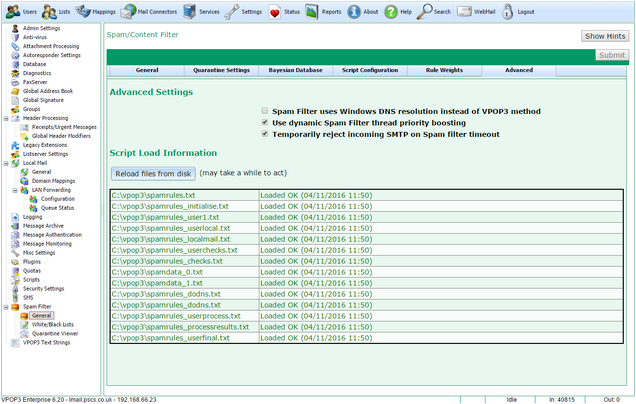
To get to this page, go to Settings → Spam Filter → General → Advanced.
The Spam filter Advanced settings let you change settings you would normally never need to alter.
If the Spam Filter uses Windows DNS resolution instead of VPOP3 method option is checked, then VPOP3 uses the slower standard Windows method for resolving DNS 'A' records, rather than VPOP3's multithreaded high performance method. Usually this option should be turned off, but if the spam filter is having DNS problems it can be worth trying turning this option on instead. The VPOP3 spam filter performs a large number of DNS lookups on each incoming message. Occasionally because there is a large number of DNS queries performed very quickly this can upset a badly implemented DNS server, but this is rare nowadays.
The Use dynamic Spam Filter thread priority boosting option tells VPOP3 that if VPOP3 is processing several messages at once, once a message has been processed for several seconds, VPOP3 will boost the thread priority in Windows to try to get the message processed more quickly and avoid the spam filter from timing out. Usually this is checked.
The Temporarily reject incoming SMTP on Spam filter timeout option tells VPOP3 that if an incoming SMTP message causes the spam filter to timeout, then VPOP3 will send a temporary reject message to the sender to tell them to try again later. If this is not checked, then VPOP3 will accept the message without spam filtering it in this case. Usually if you have a large number of spam filter timeouts it means that you have configured VPOP3 to have too many incoming SMTP sessions for the server specifications. You should consider reducing the SMTP service's Maximum incoming sessions setting. Usually this option is checked.
The Script Load Information section displays if VPOP3 loaded the spam filter script files, and when it loaded them. Any errors are reported here. An error code of '2' indicates that the file is missing, which is probably OK, if the file is a 'spamrules_user......' file because these are optional.
Note that the list of files can change on different installations. The only fixed file is the 'spamrules.txt' file, and that script file includes other files, so in different installations, different files may be included.
If you have had a problem such as a virus scanner blocking files or something, then pressing the Reload files from disk will trigger VPOP3 to reload the files, but that may not take place immediately. VPOP3 only checks to see if it should reload the files periodically to avoid a big performance hit.

